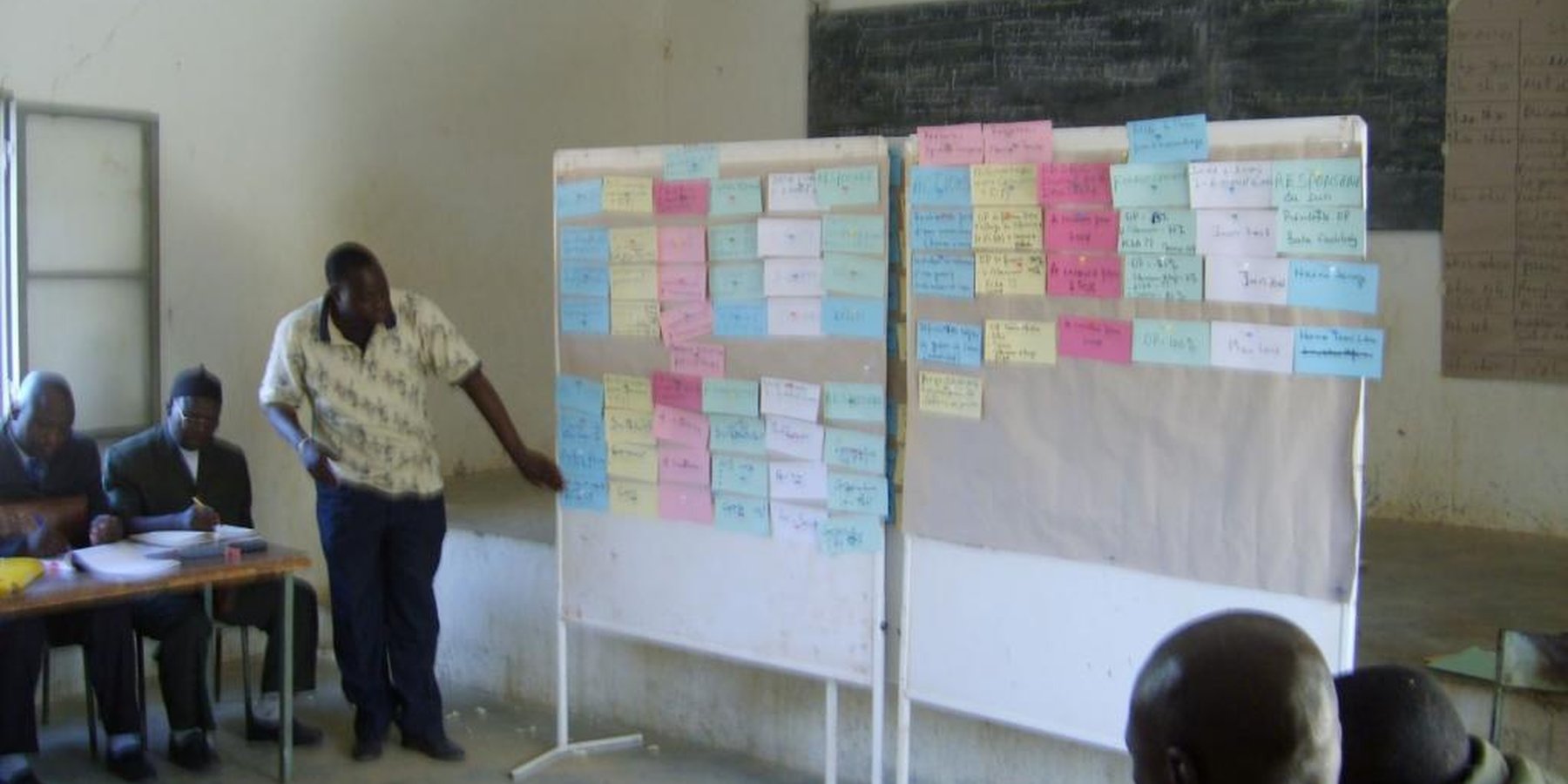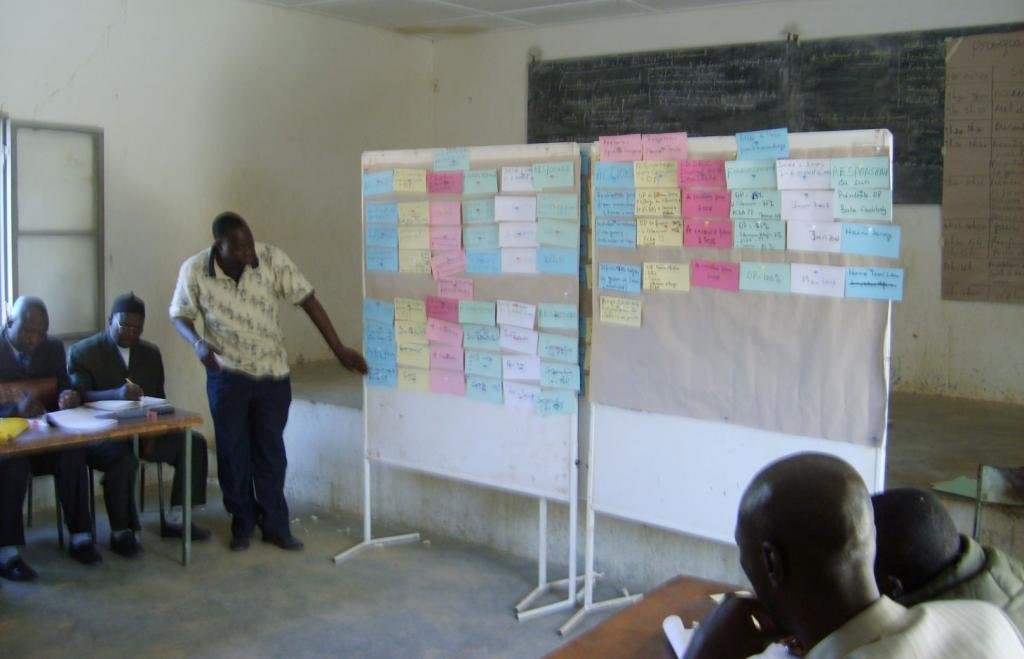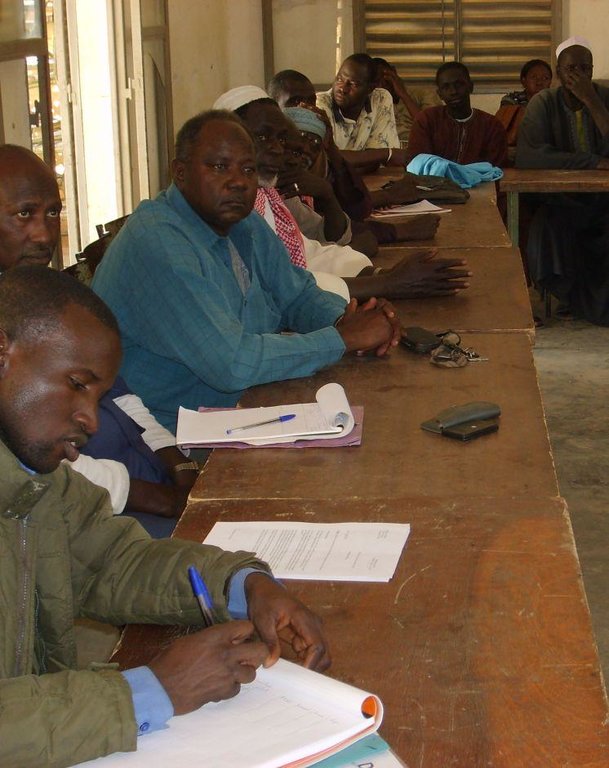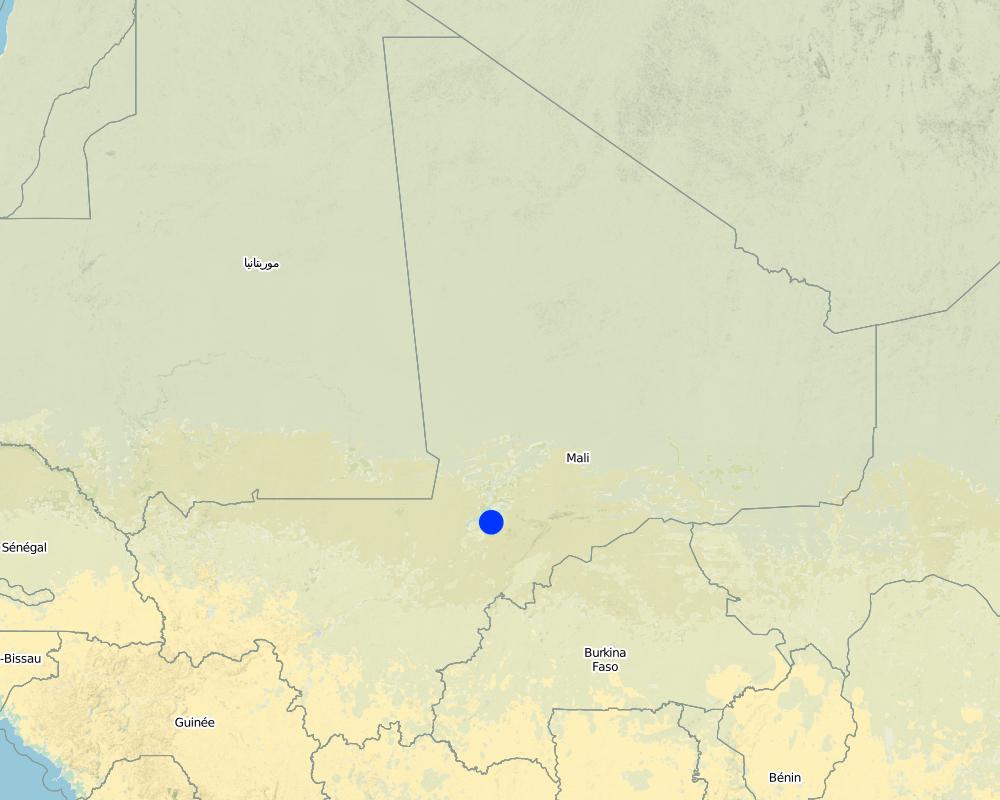Establishment and support of coordination platforms for commune and private sector collaboration [Mali]
- Creation:
- Update:
- Compiler: Dieter Nill
- Editor: –
- Reviewer: Laura Ebneter
Mise en place et accompagnement des cadres de concertation entre la commune et le secteur prive
approaches_2512 - Mali
View sections
Expand all Collapse all1. General information
1.2 Contact details of resource persons and institutions involved in the assessment and documentation of the Approach
SLM specialist:
Cisse Dieneba
dieneba.cisse@giz-pact.org
Deutsche Gesellschaft für Internationale Zusammenarbeit (GIZ)
Mali
Name of project which facilitated the documentation/ evaluation of the Approach (if relevant)
Programme for Territorial Communities, Mali (PACT)Name of the institution(s) which facilitated the documentation/ evaluation of the Approach (if relevant)
Deutsche Gesellschaft für Internationale Zusammenarbeit (GIZ) GmbH (GIZ) - Germany1.3 Conditions regarding the use of data documented through WOCAT
When were the data compiled (in the field)?
01/07/2012
The compiler and key resource person(s) accept the conditions regarding the use of data documented through WOCAT:
Yes
2. Description of the SLM Approach
2.1 Short description of the Approach
Facilitate dialogue between commune representatives and sector players in order to direct investments and commune services towards the real needs of professionals.
2.2 Detailed description of the Approach
Detailed description of the Approach:
Consultation frameworks aim to facilitate dialogue between commune representatives and sector players in order to direct investments and commune services towards the real needs of professionals in the sectors in question.
The approach involves instituting a consultation framework for local authority actors and professionals from economic sectors in order to identify these economic actors’ needs vis-à-vis community investments, to factor these needs into local and regional authority planning, and to promote trust and collaboration between actors.
The commune identifies two or three high-growth sectors that are a priority for the commune and also identifies the actors (groups, cooperatives, associations) operating in these sectors. It then puts a consultation framework in place that brings together the municipality, sector actors, local technical services, representatives from technical and funding partners, and NGOs appropriate to or operating in the sectors in question. The decision to establish a framework is made on the back of commune council deliberations. Prior to the first consultation framework meeting, sector professionals identify their needs in terms of investments and measures to improve the business environment. During these periodic meetings, attendees negotiate and agree on priority actions and write these up in a very short-term (three-month) action plan. The consultation framework group then moves to install an inclusive monitoring committee to oversee the implementation of the action plan. The committee’s mandate is defined and evolves in accordance with the results that are achieved over time and with new needs arising. The successive nature of the consultation framework meetings means that progress can be measured, required adjustments made and new activities programmed to move the sectors forward.
PACT provides technical support (methods and tools for work, moderation and training) and contributes financially to consultation workshops. The commune formalises the framework, organises the logistics of meetings (invites, meeting rooms, chair hire, accommodation), contributes to implementing the action plan (registering its designated actions with PDESC, financing), provides incentives (supporting the training of cooperatives; land access; linking up actors; acting as intermediary in negotiations among cooperatives, technical and financial partners and NGOs). Professional organisations mobilise and train their members, cover the costs of their designated activities (radio reports, member travel arrangements, opening accounts, etc.), identify and negotiate within each individual profession the required actions for inclusion in the action plan, and contribute to the cost of building infrastructure. Technical services provide technical support to the two main parties (municipality and professional organisations). The monitoring committee helps ensure the action plan is implemented on schedule, identifies obstacles to implementation and communicates these to consultation framework actors so they can find solutions and move forward with a new action plan.
2.3 Photos of the Approach
2.5 Country/ region/ locations where the Approach has been applied
Country:
Mali
Region/ State/ Province:
Mali
Further specification of location:
regions of Ségou and Koulikoro
Map
×2.6 Dates of initiation and termination of the Approach
Indicate year of initiation:
2007
2.7 Type of Approach
- project/ programme based
2.8 Main aims/ objectives of the Approach
Consultation frameworks aim to facilitate dialogue between commune representatives and sector players in order to direct investments and commune services towards the real needs of professionals in the sectors in question.
The SLM Approach addressed the following problems: lack of dialogue between commune representatives and sector players
2.9 Conditions enabling or hindering implementation of the Technology/ Technologies applied under the Approach
institutional setting
- hindering
lack of dialogue between commune representatives and sector players
Treatment through the SLM Approach: instituting a consultation framework for local authority actors and professionals from economic sectors in order to identify economic actors’ needs and to factor these needs into local and regional authority planning, to promote trust and collaboration between actors.
3. Participation and roles of stakeholders involved
3.1 Stakeholders involved in the Approach and their roles
- local land users/ local communities
- SLM specialists/ agricultural advisers
- local government
- national government (planners, decision-makers)
- international organization
3.2 Involvement of local land users/ local communities in the different phases of the Approach
| Involvement of local land users/ local communities | Specify who was involved and describe activities | |
|---|---|---|
| initiation/ motivation | passive | |
| planning | interactive | |
| implementation | interactive | |
| monitoring/ evaluation | interactive | The monitoring committee helps ensure the action plan is implemented on schedule, identifies obstacles to implementation and communicates these to consultation framework actors so they can find solutions and move forward with a new action plan |
| Research | passive |
3.4 Decision-making on the selection of SLM Technology/ Technologies
Specify who decided on the selection of the Technology/ Technologies to be implemented:
- mainly SLM specialists, following consultation with land users
Explain:
Decisions on the method of implementing the SLM Technology were made by mainly by SLM specialists with consultation of land users
4. Technical support, capacity building, and knowledge management
4.1 Capacity building/ training
Was training provided to land users/ other stakeholders?
Yes
Specify who was trained:
- land users
If relevant, specify gender, age, status, ethnicity, etc.
Training provided/supported by PACT, the commune, professional organisations
Form of training:
- public meetings
4.2 Advisory service
Do land users have access to an advisory service?
Yes
Describe/ comments:
Name of method used for advisory service: technical support (methods and tools for work, moderation and training), financial contribution
4.3 Institution strengthening (organizational development)
Have institutions been established or strengthened through the Approach?
- yes, greatly
Specify the level(s) at which institutions have been strengthened or established:
- local
Specify type of support:
- financial
- capacity building/ training
- equipment
4.4 Monitoring and evaluation
Is monitoring and evaluation part of the Approach?
Yes
Comments:
socio-cultural aspects were ad hoc monitored by project staff, land users through observations
economic / production aspects were regular monitored by project staff, land users through measurements
management of Approach aspects were ad hoc monitored by project staff through observations
There were no changes in the Approach as a result of monitoring and evaluation
There were no changes in the Technology as a result of monitoring and evaluation
4.5 Research
Was research part of the Approach?
Yes
Specify topics:
- sociology
- economics / marketing
5. Financing and external material support
5.1 Annual budget for the SLM component of the Approach
Comments (e.g. main sources of funding/ major donors):
Approach costs were met by the following donors: international: 100.0%
5.2 Financial/ material support provided to land users
Did land users receive financial/ material support for implementing the Technology/ Technologies?
Yes
If yes, specify type(s) of support, conditions, and provider(s):
The beneficiaries (municipality and professional organisations) contribute to covering the costs involved. It is a win-win process for the municipality and professional organisations and the costs involved are low. Progress can potentially be restricted by the low-levels of resources that both the territorial communities (rural communes) and local economic actors can invest in infrastructure and the fact that PACT cannot make capital investments. This lack of investment can sap the desire of actors to continue with the consultation process.
5.3 Subsidies for specific inputs (including labour)
- equipment
| Specify which inputs were subsidised | To which extent | Specify subsidies |
|---|---|---|
| machinery | fully financed | |
| tools | fully financed | |
If labour by land users was a substantial input, was it:
- rewarded with other material support
5.4 Credit
Was credit provided under the Approach for SLM activities?
No
6. Impact analysis and concluding statements
6.1 Impacts of the Approach
Did the Approach help land users to implement and maintain SLM Technologies?
- No
- Yes, little
- Yes, moderately
- Yes, greatly
consultation framework brings together the municipality, sector actors, local technical services, representatives from technical and funding partners, and NGOs; Commune water-use planning that takes into account commercial (e.g., small-scale irrigation schemes) as well as drinking water purposes
Did the Approach empower socially and economically disadvantaged groups?
- No
- Yes, little
- Yes, moderately
- Yes, greatly
Did other land users / projects adopt the Approach?
- No
- Yes, little
- Yes, moderately
- Yes, greatly
Ségou Region: Ségou Circle (communes of Dioro, Sansanding, Togou, Markala and Farakou Massa) and Macina Circle (communes of Boky-Wèrè, Kokry, Souleye, Saloba and Kolongo) Implementation locations: Koulikoro Region: Koulikoro Circle (communes of Sirakorala, Koula Togouni, Nyamina and Doumba) and Kati Circle (communes of Ouélessébougou, Dialakoroba, Sanankoroba, Dio-Gare and Yélékébougou). The approach has been applied in 20 communes in two regions and four circles. On average, each commune has two cooperatives, which are professional organisations representing between 60 and 120 members.
Did the Approach lead to improved livelihoods / human well-being?
- No
- Yes, little
- Yes, moderately
- Yes, greatly
trust and collaboration between actors; consultation framework brings together the municipality, sector actors, local technical services, representatives from technical and funding partners, and NGOs
Did the Approach help to alleviate poverty?
- No
- Yes, little
- Yes, moderately
- Yes, greatly
6.2 Main motivation of land users to implement SLM
- increased production
- increased profit(ability), improved cost-benefit-ratio
- payments/ subsidies
6.3 Sustainability of Approach activities
Can the land users sustain what has been implemented through the Approach (without external support)?
- uncertain
If no or uncertain, specify and comment:
The most important factor in ensuring success is a willingness to collaborate on the part of the municipality (whose revenue is based on taxes paid by economic actors) and economic actors who have expectations with regard to the installation of infrastructure/community facilities for trade and to business opportunities that the municipality can facilitate. Levels of success are strongly linked to the support provided to the two main actors, namely:
1) training and support for the municipality in managing the local development, mobilising resources, and negotiating and developing partnerships;
2) training and support for economic actors in formalising the cooperative or company, mobilising and securing financial resources, setting up and managing projects, and negotiating and implementing partnerships.
6.4 Strengths/ advantages of the Approach
| Strengths/ advantages/ opportunities in the compiler’s or other key resource person’s view |
|---|
| The beneficiaries (municipality and professional organisations) contribute to covering the costs involved. It is a win-win process for the municipality and professional organisations and the costs involved are low. |
|
Formalisation of professional organisations and steering of these towards economic goals. Increased awareness in the municipality of the need to include economic factors in planning |
|
Commune water-use planning that takes into account commercial (e.g., small-scale irrigation schemes) as well as drinking water purposes |
|
collaborative relationship between the municipality and private sector (better mutual understanding of local authority and professional sector actors) |
| embedding of community structural investments in community planning |
| Greater willingness to pay taxes |
| creation of new funding streams for local authorities |
| empowerment of private sector actors in terms of investments |
| Improved basic community services for actors operating in sectors related to small-scale irrigation |
| Joint identification of needs (investments and capacity building of actors). |
6.5 Weaknesses/ disadvantages of the Approach and ways of overcoming them
| Weaknesses/ disadvantages/ risks in the compiler’s or other key resource person’s view | How can they be overcome? |
|---|---|
| Progress can potentially be restricted by the low-levels of resources that both the territorial communities (rural communes) and local economic actors can invest in infrastructure and the fact that PACT cannot make capital investments. This lack of investment can sap the desire of actors to continue with the consultation process. |
7. References and links
7.1 Methods/ sources of information
- field visits, field surveys
- interviews with land users
7.2 References to available publications
Title, author, year, ISBN:
Manual of Good Practices in Small Scale Irrigation in the Sahel. Experiences from Mali. Published by GIZ in 2014.
Available from where? Costs?
http://star-www.giz.de/starweb/giz/pub/servlet.starweb
Links and modules
Expand all Collapse allLinks
No links
Modules
No modules





